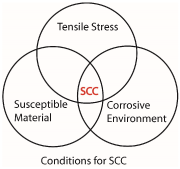E-Archive
Articles
in Vol. 22 - July Issue - Year 2021
Stress Corrosion Cracking and Residual Stress

Figure 1: Synergy required for SCC to occur
![Figure 2: Residual stress vs. depth profiles and bending fatigue S-N curves of Ck-45 tested in sea water. [ref. J.E. Hack and G.R. Leverant, “Residual Stress Effects in Fatigue,” STP 776, ASTM, 1982, p 204]](https://www.mfn.li/storage/e-archives/article-pictures/2117/6520.gif)
Figure 2: Residual stress vs. depth profiles and bending fatigue S-N curves of Ck-45 tested in sea water. [ref. J.E. Hack and G.R. Leverant, “Residual Stress Effects in Fatigue,” STP 776, ASTM, 1982, p 204]

Figure 3: Effect of split-sleeve cold expansion on a fastener hole
Stress corrosion cracking (SCC), also known as environmentally assisted cracking, and sometimes characterized as stress-assisted grain boundary oxidization (SAGBO) in high-temperature applications, is a major source of potential failures in the power industry, as well as in process industries, pulp mills, storage vessels, and even aircraft structures. Sustained tensile stresses (resulting from the superposition of residual and applied stresses) above materials’ SCC thresholds is the main reason for corrosion cracking (see Figure 1); the other two factors are susceptible materials and environments that are often only slightly corrosive to that material. SCC is characterized by selective intergranular corrosion that causes multiple cracks to initiate and eventually propagate.
There are several possible solutions to the SCC problem. The first and most obvious solution is to change the environment, but that is rarely possible. The addition of a coating can, in principle, break the SCC synergy by sequestering the material from its environment, but this is often impractical or only a short-term solution, as the coating could wear or degrade over time. Another obvious solution is to change the material to one less susceptible to SCC, but that can be very expensive or impractical. Thermal stress-relieving can be used to help reduce the magnitude of tensile residual stresses to levels below the SCC threshold; however, if the heating approaches the annealing temperature, as would be required to effectively stress-relieve the component, the heat treatment itself may negatively affect the desired material’s mechanical properties. Heat treatment is therefore only a partial solution in many instances. There are some special cases in which heat treatment may minimize the susceptibility of certain materials to SCC, but this approach does not work for all materials. Nevertheless, for applications in which the applied tensile stresses alone approach or exceed the SCC threshold, thermal stress-relief would be insufficient to overcome the contribution of sustained in-service loading. Corrosion engineers have thus long recognized that in many instances, the only effective solution to the SCC problem is the introduction of compressive residual stresses.
There are a wide variety of stress-management methodologies that can be used to impart compressive residual stresses into a component: peening, rolling, expanding, etc., as well as their variants. Some of these variants are usually applied at the time of fabrication (e.g., shot peening, laser shock peening, rolling, etc.), whereas others can be applied in the field on components already in service (e.g., ultrasonic impact treatment, flapper peening, split-sleeve cold expansion, etc.). If the compressive residual stresses imparted are great enough to overcome the sustained in-service applied stresses to a level below the SCC threshold, the SCC synergy can be broken.
Residual stress measurement methods, including x-ray diffraction, can be used to characterize the stress state of components that may be susceptible to SCC either before or after they have been put into service. Quantitative verification of the effectiveness of stress management methodologies is important in ensuring that a compressive residual stress of sufficient magnitude has been introduced to overcome any in-service applied stresses while remaining below the SCC threshold. In the case of the data shown in Figure 2, residual stress measurements obtained via XRD were used to compare the effects of grinding and shot peening on the surface and subsurface residual stress states of a component prior to being placed into service. Once a component has already been placed into service, the effect of a given stress-management methodology can also be evaluated. In the case of a fastener hole in an aluminium alloy structure, the effect of drilling and reaming only versus drilling, reaming, and split sleeve cold expansion was measured using XRD (see Figure 3). It can be seen that the split-sleeve cold expansion process introduced compressive residual stresses at the edge of the hole (high stress location most susceptible to failure) thus eliminating RS from the Venn diagram in Figure 1. Once the synergy of the SCC triangle has been broken, the susceptibility of the component to SCC in service can be significantly diminished or eliminated altogether, thus improving in-service life and reliability.
For Information:
Proto Mfg. Inc.
12350 Universal Drive
Taylor, Michigan, USA, 48180
Tel. +1.313-965-2900
Fax +1.734-946-0975
E-mail: xrdlab@protoxrd.com
www.protoxrd.com



























